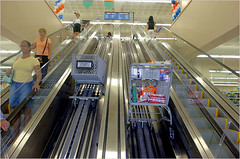Retail musings
(Bethesda Row image by Fredosan.
As I write over and over and over and over again, why is it that the suburban developers (well, not the Lerners) like Federal Realty understand the idea and importance of "urban retail" from the design standpoint (even if still sanitized in terms of grit, people of color, and independent businesses, except maybe for restaurants) and cities--which are naturally "urban" do not.
This came up in an interview I did yesterday about some issues about the Anacostia Waterfront Intitiative. I have come to believe that the (re)development of this asset is one of the biggest issues for the next generation of planning and development in our city. The baseball stadium is just one piece.
Something that really bothers me about it is that it appears as if many of the AWI executives have Inner Harbor and ideas of shopping malls foremost on their mind, and Inner Harbor is the definition of inauthenticity.
The Post had a good Business story Sunday on the rise of "lifestyle centers" which for the most part are faux Main Streets 100% devoted to commerce, with few if any mixed-use aspects or public, non-profit, and government functions. The article, "Old Magnets Just Don't Attract," discusses how with the decline of department stores, malls are transforming into outdoor-oriented places and big (chain) restaurants and movie theaters are replacing department stores. (G-d I wish they'd get a few storefront churches....)
The online story doesn't have most of the images that the article included. They are very good, but Bethesda Row in Bethesda is a good example.
But while suburban developers are doing "rows" DC is building car-centric and/or chain-centric shopping centers:
1. Brentwood Center
2. Costco Shopping Center off South Dakota Avenue SE
3. Whatever crap ends up on the Anacostia Waterfront
4. Whatever crap ends up at Skyland Center (there is a tenstion on this project, and because of the continued advocacy of people like me, I do see that NCRC is talking about mixed-use although the foolish residents still want their faux shopping mall without mixed use, not understanding the value and improvement possiblities).
Retail Design Diva has an excellent story, "Changing Wal Mart" about WalMart's retargeting of their store development towards five segments: suburban affluent, rural, baby boomer, urban/ multicultural and Hispanic.
Plus Wal-mart has opened a multiple level store in White Plains, NY. See "A Wal-Mart Beachhead Close to New York City," from the New York Times.
 Alan Zale for The New York Times. The White Plains store has side-by-side escalators for passengers and their carts; it is one of the first of the chain’s stores to have this feature.
Alan Zale for The New York Times. The White Plains store has side-by-side escalators for passengers and their carts; it is one of the first of the chain’s stores to have this feature. And a few weeks before RDD had an excellent story on promoting great storefront windows in Cleveland in "Artful Windows...in Cleveland." From that entry:
Now Cleveland, Ohio, has come up with a new project that will both support the arts community and show local retailers that effective store windows are more about creativity than high-cost displays. "Retail Design on a Dime" will pair up local artists and designers with 10 merchants to create original installations that reflect the nature of the business and help draw customers to the stores.
Artists and designers will get a $1,000 stipend and a $250 materials budget, not to mention the publicity from being credited in the window itself as well as local media. The project is being coordinated by the Cleveland Neighborhood Development Coalition, which gets a nod from the Diva for paying attention to the "retail details." If you're interested in pursuing a similar project in your town, click here for the details.
And in a thread on Retail Wire about changes in store for Filene's Basement, commentators said some interesting stuff that I wish could percolate down to the independent businesses in DC.
1. When a retailer loses their uniqueness, repositioning is mandatory. The alternative is financial mediocrity or worse.
2. When a company has a need to change, it usually means that something isn't clicking properly; whether it be its management, strategy, systems, assortments, need for greater return for new owners or whatever. The challenge a revised Filene's Basement faces is to get its base of customers seeking "thrill kill" bargains to pay a higher price because of a label change or the "such."
Mrs. Rollins at Innervisions, an art supply store, on 8th Street SE told a story to one of my colleagues that in response to an initiative of the Barracks Row Main Street program she started working on her windows more, in part, she displays high quality expensive items in her nicely done windows. She says the stuff "flys out of her store."
I don't think she fully knows the reason why. I think I do.
People walk up and down 8th Street SE at night, because of the restaurants and bars, and Innervisions is one of the only retail stores for one, and she does a nice job with the storefront windows, plus the store is prominent, right on the corner of E and 8th Streets.
People with money to spend see the items and come back to buy.
The secret is that people are walking and window shopping, and they are a different customer segment than Mrs. Rollins might normally think about, because being closed at night (especially later at night) she might not realize that this customer segment exists.
Index Keywords: retail




0 Comments:
Post a Comment
<< Home